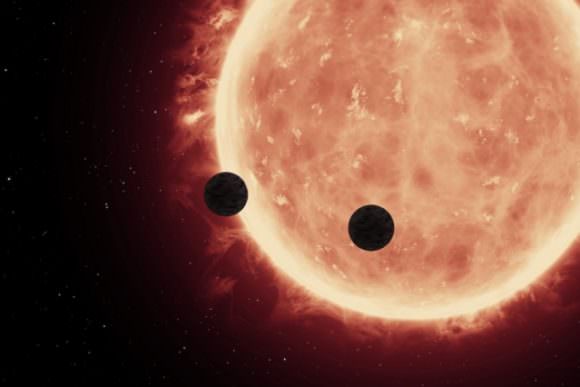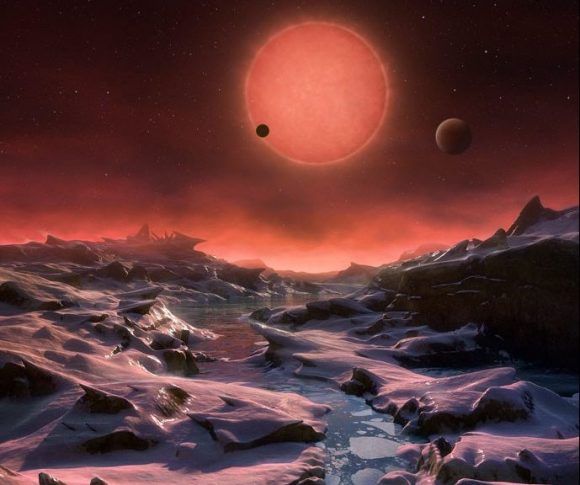 In February of 2017, a team of European astronomers announced the discovery of a seven-planet system orbiting the nearby star TRAPPIST-1. Aside from the fact that all seven planets were rocky, there was the added bonus of three of them orbiting within TRAPPIST-1’s habitable zone. As such, multiple studies have been conducted that have sought to determine whether or not any planets in the system could be habitable.
In February of 2017, a team of European astronomers announced the discovery of a seven-planet system orbiting the nearby star TRAPPIST-1. Aside from the fact that all seven planets were rocky, there was the added bonus of three of them orbiting within TRAPPIST-1’s habitable zone. As such, multiple studies have been conducted that have sought to determine whether or not any planets in the system could be habitable.When it comes to habitability studies, one of the key factors to consider is the age of the star system. Basically, young stars have a tendency to flare up and release harmful bursts of radiation while planets that orbit older stars have been subject to radiation for longer periods of time. Thanks to a new study by a pair of astronomers, it is now known that the TRAPPIST-1 system is twice as old as the Solar System.
The study, which will be published in The Astrophysical Journal under the title “On The Age Of The TRAPPIST-1 System“, was led by Adam Burgasser, an astronomer at the University of California San Diego (UCSD). He was joined by Eric Mamajek, the deputy program scientist for NASA’s Exoplanet Exploration Program (EEP) at the Jet Propulsion Laboratory.
Together, they consulted data on TRAPPIST-1s kinematics (i.e. the speed at which it orbits the center of the galaxy), its age, magnetic activity, density, absorption lines, surface gravity, metallicity, and the rate at which it experiences stellar flares. From all this, they determined that TRAPPIST-1 is quite old, somewhere between 5.4 and 9.8 billion years of age. This is up to twice as old as our own Solar System, which formed some 4.5 billion years ago.
These results contradict previously-held estimates, which were that the TRAPPIST-1 system was about 500 millions yeas old. This was based on the fact that it would have taken this long for a low-mass star like TRAPPIST-1 (which has roughly 8% the mass of our Sun) to contract to its minimum size. But with an upper age limit that is just under 10 billion years, this star system could be almost as old as the Universe itself!
As Dr. Burgasser explained in a recent NASA press statement:
“Our results really help constrain the evolution of the TRAPPIST-1 system, because the system has to have persisted for billions of years. This means the planets had to evolve together, otherwise the system would have fallen apart long ago.”The implications of this could be very significant as far as habitability studies are concerned. For one, older stars experience less in the way of flareups compared to younger ones. From their study, Burgasser and Mamajek confirmed that TRAPPIST-1 is relatively quiet compared to other ultra-cool dwarf stars. However, since the planets around TRAPPIST-1 orbit so close to their star, they have been exposed to billions of years of radiation at this point.
An artist’s depiction of planets transiting a red dwarf star in the TRAPPIST-1 System. Credit: NASA/ESA/STScl
Whereas some of these studies addressed TRAPPIST-1s level of stellar flare, others examined the role magnetic fields would play. In the end, they concluded that TRAPPIST-1 was too variable, and that its own magnetic field would likely be connected to the fields of its planets, allowing particles from the star to flow directly onto the planets atmospheres (thus allowing them to be more easily stripped away).
However, the results were not entirely bad news. Since the TRAPPIST-1 planets have estimated densities that are lower than that of Earth, it is possible that they have large amounts of volatile elements (i.e. water, carbon dioxide, ammonia, methane, etc). These could have led to the formation of thick atmospheres that protected the surfaces from a lot of harmful radiation and redistributed heat across the tidally-locked planets.
Then again, a thick atmosphere could also have an effect akin to Venus, creating a runaway greenhouse effect that would have resulted in incredibly thick atmospheres and extremely hot surfaces. Under the circumstances, then, any life that emerged on these planets would have had to be extremely hardy in order to survive for billions of years.
Artist’s impression of the view from the most distant exoplanet discovered around the red dwarf star TRAPPIST-1. Credit: ESO/M. Kornmesser.
Given the amount of time it took for complex life to have emerged on Earth (over 4.5 billion years), this longevity and consistency could make red dwarf star systems the best long-term bet for habitability. Such was the conclusion of one recent study, which was conducted by Prof. Avi Loeb of the Harvard-Smithsonian Center for Astrophysics (CfA). And as Mamajek explained:
“Stars much more massive than the Sun consume their fuel quickly, brightening over millions of years and exploding as supernovae. But TRAPPIST-1 is like a slow-burning candle that will shine for about 900 times longer than the current age of the universe.”NASA has also expressed excitement over these findings. “These new results provide useful context for future observations of the TRAPPIST-1 planets, which could give us great insight into how planetary atmospheres form and evolve, and persist or not,” said Tiffany Kataria, an exoplanet scientist at JPL. At the moment, habitability studies of TRAPPIST-1 and other nearby star systems are confined to indirect methods.
However, in the near future, next-generation missions like the James Webb Space Telescope are expected to reveal additional information – such as whether or not these planets have atmospheres and what their compositions are. Future observations with the Hubble Space Telescope and the Spitzer Space Telescope are also expected to improve our understanding of these planets and possible conditions on their surface.
Further Reading: NASA, arXiv
The post Scientists Discover TRAPPIST-1 is Older Than Our Solar System appeared first on Universe Today.

No comments:
Post a Comment